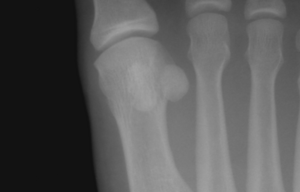Sesamoid: Difference between revisions
No edit summary |
(Added content and references) |
||
| Line 7: | Line 7: | ||
</div> | </div> | ||
== Description == | == Description == | ||
[[File:Sesamoid Bone.png|thumb]] | |||
Sesamoid bones are a type of bone that develops in some tendons where they cross the ends of long bones<ref name=":0">Moore KL, Dalley AF, R. AAM. Clinically oriented anatomy. Philadelphia, PA: Lippincott Williams and Wilkins; 2018.</ref>. Sesamoids ossify during puberty and delayed ossification can indicate delayed onset of puberty. | |||
Sesamoid bones in the human body include: | |||
* [[Patella]] - in the [[Quadriceps Muscle|quadriceps]] tendon at the knee | |||
* Hallux sesamoids - medial/tibia and lateral/fibular in the [[Flexor Hallucis Brevis|flexor hallucis brevis]] tendon at the 1st metatarsophalangeal joint | |||
* In the hand at the head of the 1st metacarpal - 1 in the combined tendon of the [[Flexor Pollicis Brevis|flexor pollicis brevis]] and [[Abductor Pollicis Brevis|abductor pollicis brevis]], 1 in the tendon of the [[Adductor Pollicis|adductor pollicis]] | |||
* [[Pisiform]] - in the [[Flexor Carpi Ulnaris Muscle|flexor carpi ulnaris]] tendon | |||
== Function == | == Function == | ||
Sesamoids protect tendons from excessive wear and act as a spacer to change the angle of tendons before the reach their attachment point<ref name=":0" />. | |||
== Clinical relevance == | == Clinical relevance == | ||
Pathology in sesamoids can be congenital or a result of trauma. Common pathology seen in sesamoid bones include: | |||
* Bipartite or multipartite patella<ref>Oohashi Y, Koshino T, Oohashi Y. Clinical features and classification of bipartite or tripartite patella. Knee Surg Sports Traumatol Arthrosc. 2010 Nov;18(11):1465-9.</ref> | |||
* [[Sesamoiditis]] | |||
* Avascular necrosis<ref>Bartosiak K, McCormick JJ. Avascular Necrosis of the Sesamoids. Foot Ankle Clin. 2019 Mar;24(1):57-67.</ref> | |||
* Fracture | |||
== Resources == | == Resources == | ||
| Line 29: | Line 35: | ||
[[Category:Anatomy]] [[Category:Bones]] | [[Category:Anatomy]] [[Category:Bones]] | ||
[[Category:Hand - Anatomy]] | |||
[[Category:Knee - Bones]] | |||
[[Category:Foot - Bones]] | |||
Revision as of 17:52, 21 February 2022
Original Editor - User:Patti Cavaleri
Top Contributors - Patti Cavaleri, Wendy Snyders and Kim Jackson
Description[edit | edit source]
Sesamoid bones are a type of bone that develops in some tendons where they cross the ends of long bones[1]. Sesamoids ossify during puberty and delayed ossification can indicate delayed onset of puberty.
Sesamoid bones in the human body include:
- Patella - in the quadriceps tendon at the knee
- Hallux sesamoids - medial/tibia and lateral/fibular in the flexor hallucis brevis tendon at the 1st metatarsophalangeal joint
- In the hand at the head of the 1st metacarpal - 1 in the combined tendon of the flexor pollicis brevis and abductor pollicis brevis, 1 in the tendon of the adductor pollicis
- Pisiform - in the flexor carpi ulnaris tendon
Function[edit | edit source]
Sesamoids protect tendons from excessive wear and act as a spacer to change the angle of tendons before the reach their attachment point[1].
Clinical relevance[edit | edit source]
Pathology in sesamoids can be congenital or a result of trauma. Common pathology seen in sesamoid bones include:
- Bipartite or multipartite patella[2]
- Sesamoiditis
- Avascular necrosis[3]
- Fracture
Resources[edit | edit source]
References[edit | edit source]
- ↑ 1.0 1.1 Moore KL, Dalley AF, R. AAM. Clinically oriented anatomy. Philadelphia, PA: Lippincott Williams and Wilkins; 2018.
- ↑ Oohashi Y, Koshino T, Oohashi Y. Clinical features and classification of bipartite or tripartite patella. Knee Surg Sports Traumatol Arthrosc. 2010 Nov;18(11):1465-9.
- ↑ Bartosiak K, McCormick JJ. Avascular Necrosis of the Sesamoids. Foot Ankle Clin. 2019 Mar;24(1):57-67.







